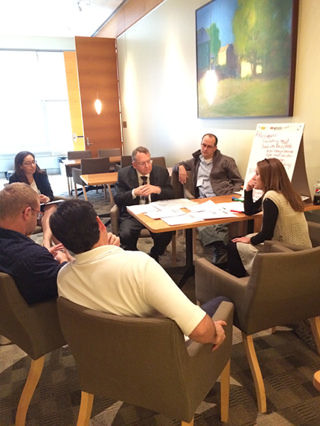
PREV ARTICLE
NEXT ARTICLE
FULL ISSUE
PREV FULL ISSUE
MORE ON THE OCTOBER 2016 U.S. MINT FORUM
A lot is being written about the hobby forum held earlier this month by the U.S. Mint. Here's a sampling of recent coverange and opinion. First up is a Numismatic News item by Pat Heller. The first part is an overview of the event, but this excerpt focuses on his group's discussion.
-Editor
Although I would have been pleased to contribute on any of these themes, the one that I would most have enjoyed, Working with Youth, was the group to which I was assigned. To give you an idea of the caliber of the attendees, this group included Dr. Feingold, Mary Burleson, two major national coin dealers, a small scale online dealer, a collector and me. The reports from these groups tended to be “small picture” ideas. For instance, the group that discussed packaging asked if it would be possible to make available some of the numismatic coins either 1) in capsules only for bulk sales where the buyers would likely be sending the coins to grading services (and at a lower selling price to reflect the lack of boxes and certificates), or 2) to put coins in flat sleeves so that they would fit in safe deposit boxes or vaults more efficiently yet would still be in original US. .Mint packaging for products owned by precious metals Individual Retirement Accounts. The Mint staff said that these ideas might be possible to implement soon since packaging was not specified in the authorizing legislation for coins. The group that discussed mintages and household order limits acknowledged that there were some problems with insufficient transparency of the ordering process for new issues. They suggested that the Mint consider a couple of ideas. First, upon initial release, the Mint might set low order limits in order to allow as many ultimate collectors as possible to have the opportunity to purchase the coins and sets. Then, a few days later, the order limits could be raised so that dealers seeking bulk quantities could do so easily. One proposal for mintage limits was to accept orders for a 30-day period, strike enough coins to fill these orders, then cut off orders. This would be a change from current specifications in authorizing legislation on the mintage limits. The suggestions from the other groups have largely been incorporated in my analysis submitted to the Mint earlier this week, as detailed at the end of this column. This tends to focus more on a “big picture” perspective. One subject that did not really come up is that there is an inherent conflict between the U.S. Mint serving collectors directly yet also working with coin dealers to help sell more of these products. If the Mint charges dealers the same price as collectors would pay, that discourages dealers from handling the newest issues. If the Mint sold to dealers at discounted prices, some dealers may charge the public a price lower than the Mint and divert potential customers away from the Mint – which has happened under some past wholesale programs. The attendees expressed a general view that U.S. Mint staffers were genuinely interested in receiving this outside feedback. When asked whether another such program should be repeated, the response was overwhelmingly in favor. When asked how often, the responses ranged from every six months to five years, with most advocating once every year or two years.
See the full article online for the complete text of Heller's analysis and recommendations.
-Editor
To read the complete article, see:
Bill Gibbs of Coin World offered this take.
-Editor
During the afternoon, participants split into teams to discuss such topics as Mint packaging, the setting of mintage maximums and household limits for products, and historic design reproduction, the team of which I was a member. Members of this team largely agreed that reusing historic designs can be a good thing for the hobby, but that legal restrictions imposed on the Mint by federal law severely hamper the effectiveness of programs like the 2016 Centennial coin series to draw in new collectors. The Mint struck the three coins, originally issued in silver 100 years ago, in gold because it has broad authority to issue gold coins without seeking congressional approval. However, issuing those coins in silver would have required an act of Congress, literally. Many of the team members would like the Mint to issue historic designs in their original specifications for collector sale, and in current compositions for circulation. Furthermore, we liked the idea of issuing the circulating versions in fairly small numbers, randomly salting them among modern designs, and then encouraging young collectors to search for them aided by an app on their phone, as in the recent Pokemon craze. This, however, would require changes to federal law, to give the Mint more leeway than it now has to issue coins. Such changes are possible (for example, the hobby drove passage of the Hobby Protection Act of 1973 and the Bicentennial coin redesign of 1975 and 1976 through concerted lobbying efforts of Congress). However, such changes will require a collaborative effort by many in the hobby. Are we up for that?
See another E-Sylum article in this issue on a similar social media-driven promotion by Ally Financial that's getting a lot of coverage in the general press this week.
-Editor
To read the complete article, see:
Here's the next part of Dennis Tucker's take on the Mint Forum in the Mint News Blog.
-Editor
Another participant pointed out that younger generations of Americans rarely see and use coins—and the same for many of their parents. Day-to-day transactions are conducted with credit and debit cards, phones, and apps. This presents a challenge when it comes to engaging young potential collectors. Still, the recent memory of the huge success of the State quarters program, which attracted tens of thousands of young collectors to the hobby—at least for a time—offers hope that coins can be relevant to them, even as countless other distractions compete for their time and attention. There was discussion about promoting numismatics to school boards, to encourage using coins as educational tools. One participant pointed out that educational curricula already are jam-packed with state-mandated requirements, making it difficult if not impossible to shoehorn new concepts into the school year. Another, however, suggested that standalone modules could be written up, maybe connecting coins to different months or seasons, giving teachers the option to plug them into their lesson plans as supplemental materials when the opportunity arises. Other ideas from the Numismatic Forum included:
To read the complete article, see:
Kudos to the Mint and Forum participants. This is a great sign of the health and future of our hobby. With dialogue and cooperation we can work togehter to make a better environment for all.
-Editor
To read the earlier E-Sylum article, see:
The Numismatic Bibliomania Society is a non-profit organization promoting numismatic literature. See our web site at coinbooks.org. To submit items for publication in The E-Sylum, write to the Editor at this address: whomren@gmail.com To subscribe go to: https://my.binhost.com/lists/listinfo/esylum All Rights Reserved. NBS Home Page Contact the NBS webmaster 
|

